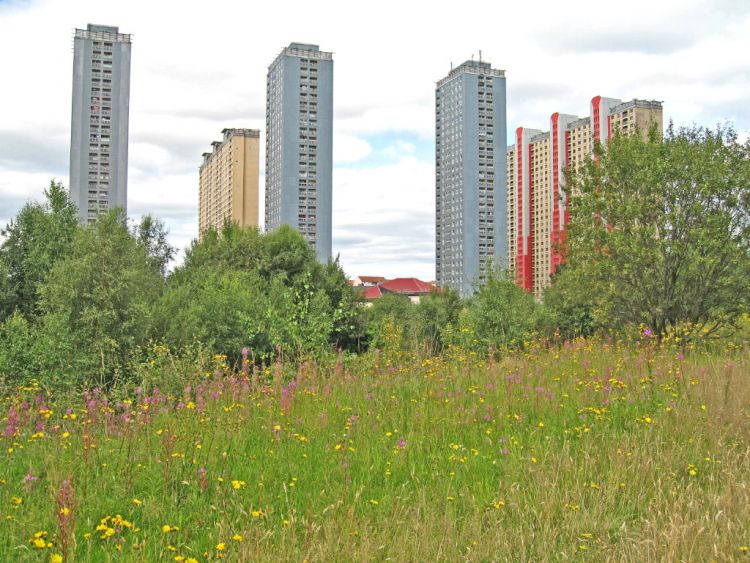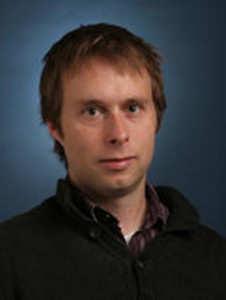A3-1: Vegetation Biodiversity – Ecosystem Functioning Relationships and Green Infrastructure Across the UWIN Network
Darrel Jenerette, PhD
University of California – Riverside
Botany and Plant Sciences
Project A3-1 looks to better understand how plants and vegetation influence the tradeoff between provisioning of ecosystem services and use of water resources. We explore components of plant density and diversity as key components of the vegetation-hydrology nexus. Key ecosystem services we look to evaluate are climate cooling and well-being of urban residents.
We are using combinations of field surveys, embedded environmental sensors, and remotely sensed imagery of the urban environment. In a recent example of this work we linked field measurements of evaporation with a tower mounted on a trailer with satellite based imagery of vegetation to generate a whole-city map of evaporation.
Environmental Sensors
In 2017 and 2018, we are deploying more than 300 air temperature sensors throughout eight metropolitan areas that represent the breadth of different climates within the United States. On the ground, we are surveying the biodiversity of green infrastructure throughout the United States to compare both types of green infrastructure and regions. This work is looking to assess how biodiversity influences the functioning and sustainability of green infrastructure projects. Together these tools will help evaluate how outdoor water use contributes to urban sustainability and resilience to environmental changes. We are exploring both vegetation writ-large within the urban environment and green infrastructure in particular.
Project Deliverables
Our work will help develop assessments of vegetation distributions to improve human well-being in the context of urban warming and drought. We will look toward identifying plant communities that maximize water use efficiency in supplying urban ecosystem services. People will benefit through better assessments of the water use by vegetation and the services provided by vegetation to better manage their landscapes.
Data
Our project will generate new data that quantify both distributions of urban vegetation and the microclimate influence of vegetation across the UWIN network of cities.
Books/Chapters
Harlan, S.L., P. Chakalian, J. Declet-Barreto, D.M. Hondula, G.D. Jenerette (in press). Pathways to climate justice in a desert metropolis. In People and Climate Change: Vulnerability, Adaptation, and Social Justice, L.M. Reyes and J. Rigg (eds.) Oxford University Press.
Journal Articles
- Avolio M, DE Pataki, GD Jenerette, S Pincetl, L Weller-Clarke, J Cavender-Bares, TW Gillespie, SE Hobbie, KL Larson, HR McCarthy, T Trammell 2019. Urban plant diversity in Los Angeles, California: Species and functional type turnover in cultivated landscapes. Plants, People, Planet DOI: https://doi.org/10.1002/ppp3.10067
- Borowy, D. & C.M. Swan. 2020. A Multi-Trait Comparison of an Urban Plant Species Pool Reveals the Importance of Intraspecific Trait Variation and Its Influence on Distinct Functional Responses to Soil Quality. Front. Ecol. Evol. https://doi.org/10.3389/fevo.2020.00068
- Crum SM and GD Jenerette. 2017. Microclimate Variation among Urban Land Covers: The Importance of Vertical and Horizontal Structure in Air and Land Surface Temperature Relationships. Journal of Applied Meteorology and Climatology 56:2531-2543. https://doi.org/10.1175/JAMC-D-17-0054.1
- Crum SM, S Shiflett, and GD Jenerette. 2017. The influence of vegetation, mesoclimate and meteorology on urban atmospheric microclimates across a coastal to desert climate gradient. Journal of Environmental Management 200:295-303 https://doi.org/10.1016/j.jenvman.2017.05.077
- Ibsen P, D Borowy, M Rochford, C Swan, GD Jenerette. 2020. Influence of climate and management on patterns of taxonomic and functional diversity of recreational park vegetation. Frontiers in Ecology and Evolution 8: DOI: 10.3389/fevo.2020.501502 https://doi.org/10.3389/fevo.2020.501502
- Ibsen PC, D Borowy, T Dell, H Greydanus, N Gupta, DM Hondula, T Meixner, MV Santelmann, SA Shiflet, MC Sukop, ML Talal, M Valencia, CM Swan, M Wright, GD Jenerette. 2021. Greater aridity increases the magnitude of urban nighttime vegetation-derived air cooling. Environmental Research Letters 6:034011 https://doi.org/10.1088/1748-9326/abdf8a
- Ibsen P, J Diffendorfer J, K Bagstad, GD Jenerette. 2022. Urban landcover differentially drives day and nighttime air temperature across a semi-arid city. Science of the Total Environment https://doi.org/10.1016/j.scitotenv.2022.154589
- Jacobsen, A. L. and Pratt, R. B. (2018), Extensive drought‐associated plant mortality as an agent of type‐conversion in chaparral shrublands. New Phytol, 219: 498-504. doi:1111/nph.15186
- Jenerette GD, LW Clarke, ML Avolio, DE Pataki, TW Gillespie, S Pincetl, J McFadden, D Nowak, L Hutyra, M McHale, and M Alonzo. 2016. Climate tolerances and trait choices shape continental patterns of urban tree biodiversity. Global Ecology and Biogeography 25:1367-1376 https://doi.org/10.1111/geb.12499
- Jenerette GD. 2018. Ecological contributions to human health in cities. Landscape Ecology 33:1655-1668. https://doi.org/10.1007/s10980-018-0708-y
- Johnson, A., Borowy, D., Swan, C. M. (2017). Land use history and seed dispersal drive divergent plant community assembly patterns in urban vacant lots. Journal of Animal Ecology. https://doi.org/10.1111/1365-2664.12958
- Liang LL, RG Anderson, SA Shiflett, and GD Jenerette. 2017. Urban outdoor water use and response to drought assessed through mobile energy balance and vegetation greenness measurements. Environmental Research Letters 084007 https://doi.org/10.1088/1748-9326/aa7b21
- Park IW, Hooper J, Flegal JM, Darrel Jenerette G. Impacts of climate, disturbance and topography on distribution of herbaceous cover in Southern California chaparral: Insights from a remote‐sensing method. Divers Distrib. 2018;24:497–508. https://doi.org/10.1111/ddi.12693
- Roman LA, H Pearsall, TS Eisenman, TM Conway, RT Fahey, S Landry, JM Vogt, NS van Doorn, JM Grove, DH Locke, AC Bardekjian, JJ Battles, M Cadenasso, CC Konijnendijk van den Bosch, M Avolio, A Berland, GD Jenerette, SK Mincey, DE Pataki, C Staudhammer, 2018. Human and biophysical legacies shape contemporary urban forests: A literature synthesis. Urban Forestry and Urban Greening 31:157-168 https://doi.org/10.1016/j.ufug.2018.03.004
- Swan, C. M., Johnson, A., Nowak, D. (2017). Differential organization of taxonomic and functional diversity in an urban woody plant metacommunity. Applied Vegetation Science, 20(1), 7-11 https://doi.org/10.1111/avsc.12266 Current Status is Published.
- Talal, M.L., M.V. Santelmann. 2019. Plant community composition and biodiversity patterns in urban parks of Portland, Oregon. Frontiers in Ecology and Evolution 04 June 2019 https://doi.org/10.3389/fevo.2019.00201
- Talal, M.L. andV. Santelmann. 2020. Vegetation management for urban park visitors: a mixed methods approach in Portland, Oregon. Ecological Applications https://doi.org/10.1002/eap.2079
- Talal, M.L. and M.V. Santelmann. 2020. Vegetation management for urban park visitors: a mixed methods approach in Portland, Oregon. Bulletin of the Ecological Society of America. 101(2):e01674. https://doi.org/10.1002/bes2.1674
- Tayyebi A and GD Jenerette. 2018. Assessing diel urban climate dynamics using land surface temperature harmonization model. International Journal of Remote Sensing 39:3010-3028 https://doi.org/10.1080/01431161.2018.1437292
- Yan J, Zhou W, GD Jenerette. 2019. Testing an energy exchange and microclimate cooling hypothesis for the effect of vegetation configuration on urban heat. Agricultural and Forest Meteorology DOI: 107666. https://doi.org/10.1016/j.agrformet.2019.107666
Updated: October 2022
Dissertations
Crum, SM (2017) “The Influence of Landscape Position on Soil Respiration and Urban Microclimate”, Ph.D. Dissertation, Ecology and Evolutionary Biology, University of California Riverside, Riverside, CA. Web: https://escholarship.org/uc/item/7ts755q2
Ibsen, P. C. (2021). Interactions of Vegetation, Climate, and Ecosystem Services From Leaf to Landscape in U.S. Cities. Ph.D. Dissertation, Plant Biology. University of California Riverside, Riverside, CA. Web: https://escholarship.org/uc/item/1cr7d6hc
Luketich, Anthony, Papuga, Shirley, Guertin, Phil, and Crimmins, Mike. Differential Impacts of Passive versus Active Irrigation on Semiarid Urban Forests (2018). MS Thesis, Natural Resources, Arizona State University. Web: https://repository.arizona.edu/handle/10150/630556
Updated: May 2021
Additional Resources
Darrel Jenerette, PhD – Principal Investigator
Associate Professor
Botany & Plant Sciences – Landscape Ecology
University of California – Riverside
Voice: (951) 827-7113
Email: Darrel.Jenerette@ucr.edu
Our research emphasizes questions that have strong theoretical implications for how biological systems work across multiple scales and directs application towards overcoming sustainability challenges. Most of our work uses sensor technology, remote sensing, field surveys, and numerical modeling techniques to generate multiple lines of evidence in answering questions. Our research has generally focused on the relationships between the carbon cycling, hydrologic cycling, energy partitioning, and biodiversity in dryland ecosystems across a diversity of land uses. We have explored these relationships both in terms of understanding carbon cycle responses to precipitation variability, and the role of vegetation for mitigating urban heat islands, and trade-offs in ecosystem services from high temperature agriculture. Together we aim to understand interacting sustainability trade-offs associated with natural, urban, and agricultural ecosystems across regional landscapes. Much of my work is collaborative and I value opportunities to work with researchers from other disciplines, institutions, and nations. I also like to analyze data for as many uninterrupted hours as possible.
Christopher Swan – Professor
University of Maryland Baltimore County
Geography & Environmental Systems
Email: Chris.Swan@umbc.edu
Mary Santelmann – Associate Professor
Oregon State University
College of Earth, Ocean & Atmospheric Sciences
Email: santelmm@oregonstate.edu
Thomas Meixner – Professor
University of Arizona
Hydrology & Water Resources
Email: tmeixner@email.arizona.edu
Students
Dorothy Borowy, University of Maryland Baltimore County: bdoro1@umbc.edu
Peter Ibsen, University of California Riverside: pibsen@ucr.edu
Julie Ripplinger, University of California Riverside: Julie.ripplinger@ucr.edu
Dion Kucera, University of California Riverside: dkucera@ucr.edu


